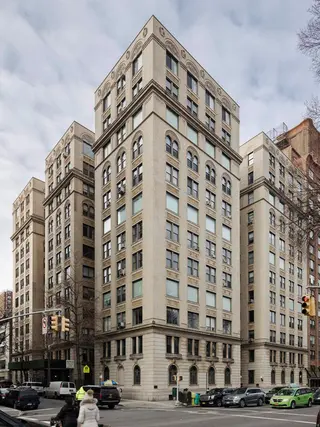 Carter Horsley
Carter HorsleyDec 23, 2011
Carter's Review
This impressive 12-story co-operative building houses at 333 Central Park West, known as the Turin, includes 72 apartments. The building, which has protruding air-conditioners, was built by the Sturtyvant Realty Company in 1909 and was designed by Albert Joseph Bodker.
The second floor windows have very handsome short wrought-iron balconies with gentle curves that are supported, in part, by scroll limestone brackets.
According to Wikipedia, the building “was the subject of a February 1995 article in The New Yorker, written by Jane Kramer; it "shed light on the remarkably dangerous, overcrowded and extremely decrepit quality of The Turin in the 1950s and the renovation it went through to become what it is today.”
Bottom Line
Most apartments have long halls which are desirable for many art collectors in need of wall space and the building’s four light courts give a lot of cross-ventilation to the units within.
Description
The building has a two-story, rusticated, limestone base and the entrance court is landscaped with a step-up entrance, beneath a half-domed glass marquee.
The building has a two-story, rusticated limestone base topped with a very pronounced and wide bandcourse. This is repeated above the 10th floor. The first-floor windows are arched and there is inconsistent fenestration above.
Above the traditional two-story rusticated limestone base are the arched windows of the first floor. The building has a very pronounced belt course that is repeated again above the 10th floor of the 12-story structure. A small belt, or stringcourse, lies above the arched windows on the ninth floor; the windows are twinned beneath larger decorative elements in terracotta. The arched terracotta ornamentation is repeated on the top floor, where there is more ornamentation beneath the large cornice.
The building's fine beige-brick façade above the limestone base is enlivened by handsome terracotta spandrels decorated with the heads of a man and a woman.
The second floor windows have very handsome short wrought-iron balconies with gentle curves that are supported, in part, by scroll limestone brackets.
Amenities
The building has a 24-hour doorman, a live-in superintendent, a fitness center, a children’s playroom, a bicycle room and storage.
Apartments
Apartments have 10-foot-high ceilings.
Apartment 56 is a four-bedroom unit with a 10-foot-long entry foyer that leads to a 17-foot-long gallery that opens onto a 30-foot-long living room and a 15-foot-wide dining room by a pantry and a 17-foot-wide, windowed kitchen and a 16-foot-long maid’s room.
Apartment 81 is a three-bedroom unit with an 8-foot-wide entry foyer that leads down a very long hall to the 27-foot-wide living room facing the park and a 15-foot-wide dining room next to the enclosed and windowed 15-foot-wide kitchen.
Apartment 21 is a three-bedroom unit with a 9-foot-long entry foyer, that turns into a 35-foot-long corridor, that brings one to a 25-foot-wide living room and an 18-foot-long dining room next to the 13-foot-wide, windowed and enclosed kitchen.
Apartment 14 is a three-bedroom unit with a 34-foot-long entry gallery that leads to a 34-foot-wide living room, a 13-foot-wide den, an 8-foot-wide laundry and the 14-foot-wide, enclosed kitchen.
Apartment 42 is a two-bedroom unit with an 8-foot-wide entry foyer that leads past a 16-foot-wide, open kitchen with an island to that 16-foot-wide dining area and the 23-foot-wide living room.
Apartment 16A is a one-bedroom unit with a 33-foot-long entry gallery that leads to a 17-foot-wide living room and a 17-foot-wide den and a 12-foot-wide enclosed and windowed kitchen.
History
"Strong lines and good proportion," wrote Andrew Alpern in his book, "New York's Fabulous Luxury Apartments With Original Floor Plans from the Dakota, River House, Olympic Tower and Other Great Buildings," (Dover Publications, Inc., 1987). "[Distinguish] 333 from its newer neighbors. Its four tower-like sections contain six large apartments per floor, all of the long hall variety. In each case the entrance to the suite is at one end of a narrow corridor leading to the living and dining rooms. The only advantage to be gained from this rather dismal arrangement is that the sleeping rooms are well removed from the entertaining spaces, which in most of the apartments include an additional windowed reception room. The building originally boasted open cage-work elevator shafts with elaborately grilled cabs, but these, alas, have long since replaced."
In his fine book, “Upper West Side Story: a History and Guide,” Peter Salwen noted that the building’s towers “were originally crowned with heavy cornices; the vertically continuous window shafts and the arches at the fifth and ninth floors still give distinction,” adding that “a recent renovation luckily emphasizes, rather than hides, the original decorations.”
Celebrities
Kramer's article also noted that some of its famous residents included actor William Hurt, film critic Pauline Kael, museum director Rene d’Harnoncourt and politician Ruth Messenger.

- Co-op built in 1909
- Located in Central Park West
- 72 total apartments 72 total apartments
- 10 recent sales ($1.9M to $9.7M)
- Doorman

 6sqft delivers the latest on real estate, architecture, and design, straight from New York City.
6sqft delivers the latest on real estate, architecture, and design, straight from New York City.
